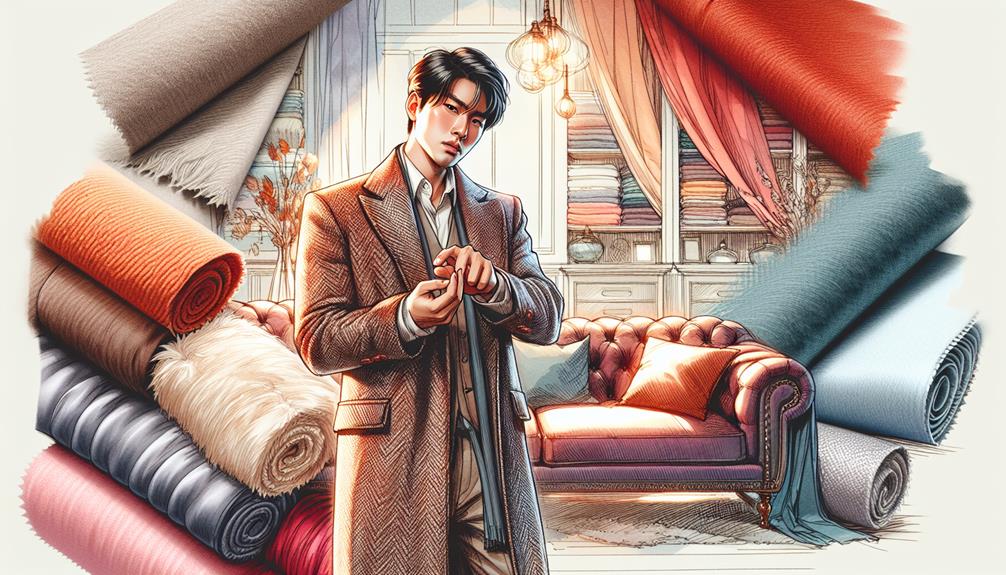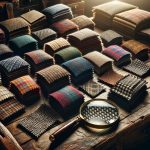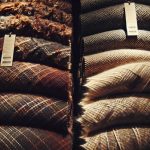I've always been a bit wary of tweed fabric. Sure, it looks classy and has that timeless appeal, but every time I've tried it on, I've ended up a bit itchy. It's made mostly from wool, which can be pretty rough on sensitive skin like mine. I've heard that there are newer tweed blends out there that are supposed to be less irritating, mixing in some synthetic fibers to soften things up a bit. This got me wondering if it might be time to give tweed another chance. Maybe it's not all tweed that's uncomfortable, and I'm curious to see if these new blends could make a difference. What do you think? Have you found a type of tweed that doesn't drive your skin up the wall?
Table of Contents
Key Takeaways
- Tweed is traditionally made from wool, which can be itchy due to its coarse fibers.
- Fiber type and quality in tweed influence its itchiness, with pure wool being itchier than blends.
- Incorporating synthetic or finer wool fibers in tweed can reduce its itchiness.
- Skin sensitivity and allergies to wool can exacerbate the feeling of itchiness when wearing tweed.
- Lining tweed garments or pre-washing them with fabric softeners can help minimize irritation.
The Basics of Tweed
Tweed, a durable and textured fabric, originated in Scotland and Ireland as practical attire for hunters and farmers. It's made primarily from wool, which gives it exceptional warmth and resilience against damp and cold weather, key features given its regions of origin. You might wonder why such a specific fabric came from these areas. Well, the local climates demanded clothing that could withstand tough, often unpredictable weather, which is why tweed's durability really stood out.
The process of creating tweed involves tightly weaving the wool in a way that retains heat yet remains breathable. This method not only enhances its durability but also contributes to its unique, often rough texture. While some find this texture slightly coarse, it's a hallmark of genuine tweed's robust nature. It's fascinating how the functionality of tweed, born out of necessity, transformed into a fashion statement, maintaining its roots in durability and practicality.
Understanding tweed's origin and its inherent durability provides a deeper appreciation of this fabric. It's not just about the aesthetics but the legacy and craftsmanship that go into every thread, making it ideal for both high fashion and everyday durability.
Common Types of Tweed
Now, let's talk about some specific types of tweed you might come across.
Harris Tweed is known for its premium quality and strict production standards, right from Scotland's Outer Hebrides.
On the other hand, Donegal tweed, from Ireland, is famous for its colorful speckles and variety.
Harris Tweed Characteristics
Among the various types of tweed, Harris Tweed stands out for its exceptional quality and traditional craftsmanship. Each piece is handwoven by islanders in their homes in the Outer Hebrides of Scotland, using local wool. This process isn't just about making fabric; it's steeped in history and pride, preserving a lifestyle and craft that dates back centuries.
The color variations in Harris Tweed are particularly striking. They range from earthy moors to vibrant heathers, reflecting the natural landscape. This diversity in hues isn't just beautiful; it's historically significant, originally crafted to blend into the natural Scottish terrain.
Here's a quick look at its unique attributes:
| Attribute | Description | Significance |
|---|---|---|
| Handwoven | Crafted in weavers' homes | Preserves traditional skills |
| 100% Wool | Uses local Scottish wool | Guarantees durability and warmth |
| Color Range | Earthy to vibrant tones | Mimics and respects natural surroundings |
Harris Tweed isn't just fabric; it's a piece of Scottish heritage.
Donegal Tweed Varieties
Shifting focus to another remarkable tweed, Donegal Tweed offers a unique spectrum of colors and textures that reflect its Irish roots. This fabric is renowned not just for its quality but also for its rich color diversity and intricate Donegal patterns. Let's explore some common types that you might encounter:
- Salt & Pepper: Mimics the rocky landscapes with its subtle blend of black and white fibers.
- Herringbone: Features a distinctive V-shaped weaving pattern, adding a classic touch.
- Tweed with flecks: Incorporates vibrant, multicolored flecks against a neutral base, embodying the lively spirit of Ireland.
- Plain Weave: Offers a simple yet elegant style, focusing on texture over pattern.
- Checked: Showcases a balanced use of color with symmetrical squares or rectangles.
These varieties ensure that there's a Donegal Tweed to suit anyone's style.
Tweed Weaving Techniques
Let's immerse ourselves in the fascinating world of tweed weaving techniques, where skilled artisans transform simple threads into intricate patterns.
The mastery of loom settings and thread tension is essential here. These settings adjust how tightly the thread is held, impacting the texture and durability of the tweed. By varying the tension, weavers can create different feels—from soft and supple to robust and coarse.
Each type of tweed, from Harris to Donegal, relies on specific weaving techniques that dictate its unique characteristics. Understanding these nuances not only helps in choosing the right tweed for your needs but also in appreciating the craftsmanship behind each fabric.
It's all about precision and skill in manipulating these elements to achieve the desired fabric quality.
Why Tweed Can Be Itchy
Tweed can be itchy because it's often made from coarse wool fibers. Though known for its durability and charm, the nature of the fabric can sometimes lead to discomfort, especially if you're sensitive to texture. The coarseness of the wool primarily stems from the types of sheep the wool is harvested from, as well as the specific spinning methods used to create tweed. This can affect the fabric's softness and how it feels against the skin.
Furthermore, the way tweed garments are constructed can contribute to itchiness. If the tweed isn't lined, the rough interior surface of the fabric can directly contact the skin, leading to irritation. Here are a few more reasons why tweed might feel itchy:
- Fabric Density: Tweed's tightly woven nature increases its texture, which can irritate the skin.
- Fiber Length: Shorter fibers can protrude from the yarn, causing a prickling sensation.
- Processing Chemicals: Chemicals used in dyeing and treating the wool can leave residues that aggravate the skin.
- Personal Sensitivity: Individual sensitivity to wool can make even well-processed tweed feel itchy.
- Wear and Tear: Older or well-worn tweed garments may become rougher, enhancing the itch factor.
Understanding these elements can help you choose or modify tweed clothing for better comfort.
Composition and Weave
Moving on, we'll explore how the specific composition and weave of tweed contribute to its unique characteristics. When I talk about tweed, I'm referring to a fabric known for its complexity and texture, which directly ties into its manufacturing processes. Let's dig into how these elements impact its feel and overall performance.
Tweed's distinctiveness largely comes from its twill weave. This method intertwines the weft and warp in a staggered pattern, creating a diagonal ribbing. This structure not only gives tweed its classic look but enhances fabric durability. The tightness of the weave and the quality of the yarn also play pivotal roles. Better quality in these areas typically reduces the itchiness and increases the lifespan of the fabric.
Here's a quick breakdown:
| Aspect | Significance in Tweed | Impact on Itchiness |
|---|---|---|
| Weave Pattern | Twill | Reduces surface roughness |
| Yarn Quality | High-quality yarns | Minimizes skin irritation |
| Weave Tightness | Dense | Enhances fabric durability, reduces loose fibers |
| Manufacturing | Precise techniques | Guarantees consistent texture |
Understanding these components helps us appreciate why tweed behaves the way it does. It's not just about how it's made; it's the meticulous attention to detail in its creation that defines its performance and feel.
Impact of Fiber Content
The type of fibers used in tweed greatly influences its texture and comfort levels. As someone who's explored the world of fabrics, I've discovered that the itchiness often attributed to tweed can mostly be attributed to its fiber composition. Tweed is traditionally made from wool, which varies in softness and scratchiness depending on the sheep breed and the fiber's fineness.
To really understand why this matters, consider these points:
- Fiber Type: Pure wool tweed tends to be itchier than blends. Incorporating smoother, synthetic fibers can reduce this.
- Fiber Quality: Higher-quality, finer wool fibers are less likely to irritate the skin. They're softer and feel more luxurious.
- Production Methods: How the wool is processed and spun affects the end texture. Tweed that undergoes gentler, more refined processing methods generally results in a less scratchy feel.
- Fiber Durability: Durable fibers mean longer wearing fabric without the roughness getting worse over time. This is important for maintaining comfort.
- Weave Density: Tightly woven tweed can be stiffer and itchier. A looser weave allows for more breathability, which enhances comfort.
Understanding these elements can really change your perspective on tweed, making it easier to choose the right type for your comfort and style.
Personal Sensitivity and Allergies
I've noticed that how itchy tweed feels can really depend on your own skin sensitivity and if you've got allergies.
If your skin often reacts to fabrics, it's important to figure out if you're allergic to tweed or just sensitive to its texture.
For those with serious reactions, looking into hypoallergenic alternatives might be a good move.
Skin Reactions to Tweed
Some people find that tweed fabric causes skin irritation due to personal sensitivities or allergies. If you're keen on minimizing discomfort while wearing tweed, consider the following strategies:
- Pre-Wash with Fabric Softeners: This can soften the fabric, reducing potential irritation.
- Choose Lined Tweed Garments: Lining can act as a barrier between your skin and the tweed.
- Undergarments as a Shield: Wear a long sleeve shirt under tweed jackets to minimize skin contact.
- Dermatological Tests: Get tested for specific fabric allergies to identify if tweed is a trigger.
- Seek Hypoallergenic Tweed: Some brands offer tweed that's treated to be less irritating for sensitive skin.
These tips can help you enjoy tweed without the itch!
Identifying Allergic Responses
To determine if you're allergic to tweed, start by noting any immediate skin reactions after wearing it. If you notice redness, itching, or bumps, it's a heads-up that you might be sensitive. It's important to differentiate between a rough texture irritation and a true allergy. For a clear verdict, consider allergy testing. This can confirm whether it's the tweed or something else causing your symptoms.
Once you know it's an allergy, reaction management becomes key. Learn to recognize early signs of discomfort. If symptoms appear, acting fast with antihistamines or a topical cream can help manage the irritation. Always consult a healthcare provider for personalized advice and treatment options tailored to your specific condition.
Hypoallergenic Fabric Alternatives
If you find tweed irritates your skin, exploring hypoallergenic fabric alternatives can offer comfort without sacrificing style. When I started looking for materials that wouldn't aggravate my allergies, I found several great options that feel good and look fantastic.
Here are some hypoallergenic choices you might consider:
- Bamboo: Naturally soft and breathable, great for sensitive skin.
- Silk Blends: Luxurious and less likely to cause reactions compared to many other fabrics.
- Organic Cotton: Free from harsh chemicals, making it a solid choice in cotton comparisons.
- Linen: Known for its natural fibers and breathability.
- Tencel: Eco-friendly and moisture-wicking, perfect for keeping skin irritation at bay.
Switching to these fabrics has made a world of difference for me!
Choosing the Right Tweed
When choosing the right tweed, consider both the fabric's texture and its weave pattern to guarantee maximum comfort and style. Tweed's unique charm isn't just in its classic look; it's also in its durability. A tightly woven tweed can withstand wear and tear better than many fabrics, making it a fantastic investment for your wardrobe.
Now, let's talk about seasonal suitability. Tweed is traditionally associated with cooler weather due to its dense, woolen make-up which keeps you warm. However, modern variations have adapted to all seasons. Lightweight tweeds are perfect for spring and autumn, providing breathability without sacrificing that distinctive tweed appearance. For summer, opt for tweeds that blend wool with lighter fibers like cotton or linen to keep things cool yet stylish.
Selecting the right tweed also means looking at the finish and color. A softer finish can reduce potential itchiness, an important consideration with wool fabrics. Colors and patterns also play an important role; they should complement your existing wardrobe and suit the occasions you're dressing for. Remember, the right tweed isn't just about looking good, it's also about practicality and comfort.
Tips to Reduce Itchiness
So, if you're finding your tweed a bit itchy, I've got some handy tips to help you out.
First, picking a tweed with a soft lining can make a huge difference in comfort.
Also, giving your tweed a good wash before you wear it for the first time can help soften it up a bit.
Choose Soft Linings
Choosing a soft lining for your tweed garment can greatly reduce itchiness. When you're picking out a lining, you want something that'll feel comfortable against your skin and enhance the fabric's breathability. Here's what I'd recommend:
- Silk: It's smooth, naturally hypoallergenic, and promotes better air flow.
- Cotton: Soft, breathable, and available in various colors to match your tweed.
- Polyester blends: These are durable and less expensive while still soft.
- Satin: Offers a luxurious feel and slides easily, preventing irritation.
- Bemberg: A popular choice for its silky texture and moisture-wicking properties.
Wash Before Wearing
Washing your tweed garment before wearing it can greatly reduce its itchiness. Here's how I handle it: I use a mild detergent and cool water, as hot water can shrink the fabric. I always add a bit of fabric softener, because it helps soften the fibers, making the tweed less scratchy against my skin.
For an extra layer of comfort, you can also try a pre-wear treatment. This involves soaking the tweed in a mixture of water and fabric conditioner before the first wash. Gently agitate the fabric in the solution, then rinse thoroughly. This step helps to relax the fibers right from the start, ensuring the tweed is more comfortable to wear after it dries.
Select Quality Tweed
When selecting tweed, opting for high-quality material can greatly lessen the itchiness often associated with this fabric. It's important to understand that not all tweeds are created equal, and the quality greatly influences both comfort and durability. Here's what I look for to make sure I'm choosing the best tweed:
- Origin of Fabric: Genuine tweed from reputable sources, especially noted regions like Scotland or Ireland, where the standards are high.
- Material Blend: Pure wool tweeds or those with a high percentage of wool tend to be softer and less itchy.
- Weave Density: Tightly woven tweed offers better durability and less likelihood of irritating the skin.
- Finish: Some tweeds undergo special finishing processes to enhance softness.
- Vendor Reputation: I always check reviews and gather feedback about tweed sourcing and quality from previous buyers.
Caring for Tweed Fabrics
Proper care can keep your tweed garments looking sharp and feeling comfortable for years. Given tweed's durability, it's tempting to think it doesn't need much attention, but that's not quite right. To maintain its best condition, regular brushing and airing out are essential. This prevents buildup of dirt and preserves the fabric's natural oils.
When it comes to stain removal, act quickly. Blotting fresh stains with a clean, damp cloth can prevent them from setting in. For tougher spots, a specialized stain remover designed for wool is your best bet, but always test it on an inconspicuous area first.
I also recommend dry cleaning tweed only when necessary. Frequent dry cleaning can wear down the fibers. Instead, if it's just a bit crumpled or musty, hanging it in a steamy bathroom can work wonders. The steam helps release wrinkles without the harsh chemicals.
Lastly, when storing, I don't just shove my tweed in the closet. I use padded hangers to maintain the shape and cover it with a breathable garment bag to protect from dust. This way, my tweed stays pristine and ready for any occasion.
Alternatives to Traditional Tweed
If you find traditional tweed too itchy, there are several alternative fabrics that offer similar textures without the discomfort. Technological advancements have paved the way for modern blends that mimic the classic look and feel of tweed but are much gentler on the skin.
Here are some top alternatives that you might consider:
- Microfiber Tweed: Uses finely woven synthetic fibers, offering a smooth texture that's hypoallergenic and non-irritating.
- Cotton Tweed: A breathable option that maintains the aesthetic of traditional tweed while being softer and cooler, ideal for warmer weather.
- Wool Blends: These blends incorporate finer wools and synthetic fibers, reducing itchiness while maintaining warmth and durability.
- Bamboo Tweed: Sustainable and soft, bamboo fabric is naturally antibacterial and ideal for sensitive skin.
- Polyester Tweed: Provides durability and ease of maintenance with a softer feel, often used in performance attire due to its adaptability.
I've explored these alternatives firsthand and can vouch for their comfort and style. They're perfect for those who love the tweed look but need a more skin-friendly option. So, don't let the itch stop you from rocking that classic style!
Frequently Asked Questions
How Has Tweed Evolved in Fashion Trends Over the Decades?
Tweed's evolved from its origins as practical attire to a high-fashion staple, influenced by celebrities embracing its versatility. It's now seen in everything from casual wear to runway couture over the decades.
Can Tweed Be Dyed to Create Custom Colors?
Yes, tweed can be dyed to create custom colors, though the dyeing process varies and color retention challenges can arise, depending on the fabric blend and the quality of the dyes used.
Are There Waterproof Tweed Options Available?
Yes, there are waterproof tweed options available, boosting tweed's versatility and easing maintenance. These specially treated fabrics resist water, making them perfect for outdoor use while maintaining tweed's classic, stylish look.
How Does Tweed's Environmental Impact Compare to Other Textiles?
I've found that tweed's environmental impact varies based on production methods and material sourcing. It's generally less harmful than synthetics but more so than organic cotton, especially if not sustainably sourced.
What Are the Symbolic Meanings Associated With Different Tweed Patterns?
Tweed patterns often signify origins, like Harris Tweed reflecting Scottish heritage. Each design carries unique meanings, often tied to local histories or family lineage, showcasing cultural pride through distinct, recognizable weaves.
- Is Tweed More Expensive Than Wool? - April 24, 2024
- Is Tweed Fabric Itchy? - April 24, 2024
- How Durable Is Tweed? - April 24, 2024








